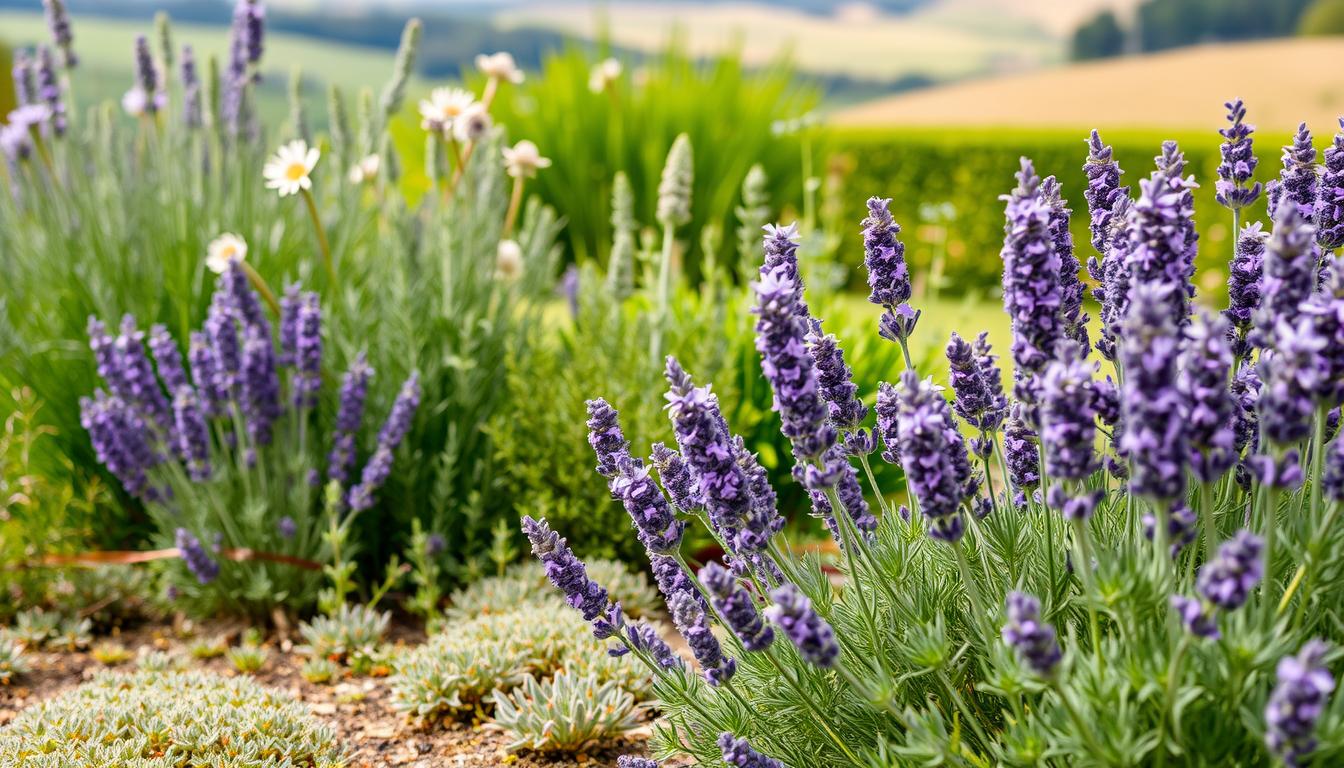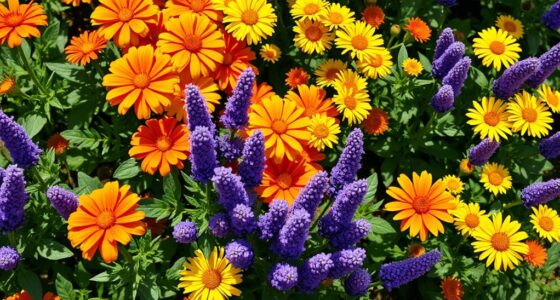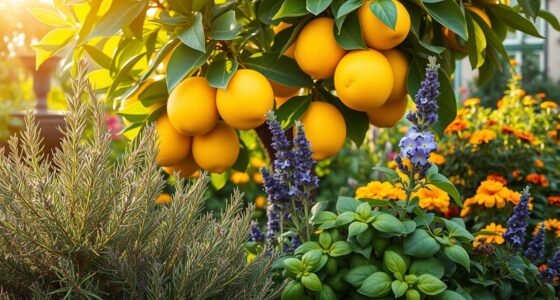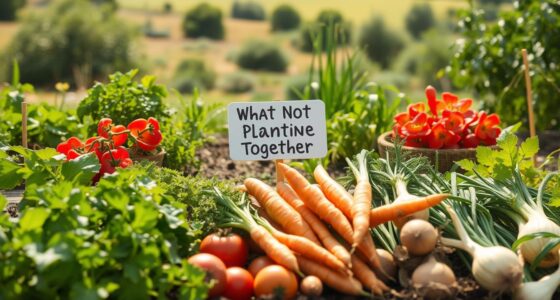Imagine stepping into your garden, welcomed by the soothing aroma of lavender wafting through the air. This stunning plant, cherished for its beauty and versatility, creates a serene atmosphere that can transform any space into a tranquil retreat. When you think of lavender, you might picture its stately purple spikes and its calming scent, but it holds even greater potential when paired with the right companions. Discovering the best plants to grow with lavender not only maximizes your garden’s potential but enriches your experience, bringing forth a tapestry of colors, textures, and scents. Lavender garden companions can elevate your peace of mind, enticing bees and butterflies while warding off pesky pests. Let’s explore these dynamic duos that fuse beauty and function in your garden.
Key Takeaways
- Lavender thrives alongside various plants, enhancing beauty and growth.
- Choosing the right lavender companion plants fosters a balanced ecosystem.
- Pairing lavender with compatible species attracts pollinators and deters pests.
- Optimizing your lavender garden involves understanding ideal growing conditions.
- Exploring diverse companion plants can enrich your gardening experience.
What Are Companion Plants for Lavender?
Companion planting with lavender involves selecting plants that provide mutual benefits, creating a harmonious garden environment. Understanding which plants serve as ideal lavender plant companions can enhance both growth and aesthetics. When considering what to plant with lavender, you will find that certain species can support lavender in pest control, moisture retention, and promote robust flavor profiles. This strategy allows you to cultivate a diverse garden while maximizing your available space.
Understanding Companion Planting Concepts
Companion planting is a gardening technique where specific plants are grown together for their complementary benefits. Plants that thrive alongside lavender often share similar growing conditions, which is essential for their overall health. By understanding these concepts, you can create a thriving ecosystem that supports the unique needs of lavender.
Benefits of Companion Planting
Benefits of companion planting extend beyond improved growth. This method can help manage pests naturally, as certain plants can deter harmful insects while attracting beneficial pollinators. Not only does this contribute to healthier plants, but it also promotes sustainable gardening practices by reducing the need for chemical interventions. Efficient use of garden space is another important aspect; combining lavender with suitable partners means utilizing every inch effectively.
Ideal Growing Conditions for Lavender
Lavender growing conditions require well-draining soil with a slightly alkaline pH, ideally between 6.5 and 7.5. Full sunlight exposure for at least 6 to 8 hours daily is crucial. Once established, lavender demonstrates drought tolerance, making it essential to choose companions with similar requirements. Understanding lavender growing tips ensures that both your lavender and its companions flourish together in perfect harmony.
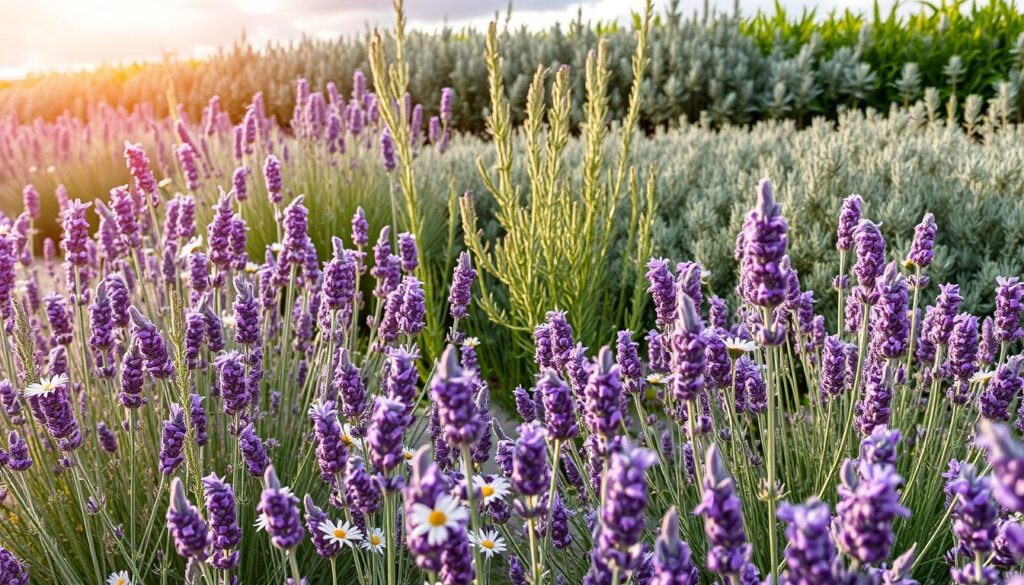
The Best Companion Plants for Lavender
Creating a stunning lavender garden involves choosing the right companions. The best plants to grow with lavender include various herbs, flowers, and vegetables that flourish alongside this aromatic favorite. Discover how you can create beautiful lavender garden combinations that enhance not just aesthetics but also growth and aroma.
Herbs That Thrive Alongside Lavender
Herbs often make excellent lavender plant companions due to their similar needs for sunlight and well-draining soil. Notable examples include rosemary, thyme, and oregano. These herbs not only enjoy the same growing conditions but also contribute unique flavors and pest-repelling properties that benefit the entire garden.
Flowers That Complement Lavender’s Beauty
When considering flowers that enhance lavender gardens, think about echinacea, black-eyed Susan, and blanket flowers. These vibrant blooms extend the flowering season and attract pollinators. Incorporating such colors into your lavender garden design not only elevates its visual appeal but also promotes healthy biodiversity.
Vegetables Compatible with Lavender
While lavender typically prefers drier conditions, there are vegetables compatible with lavender that thrive nearby. Tomatoes, peppers, and beans can coexist with lavender, particularly since lavender’s pest-repelling qualities help protect these crops. Pairing these vegetables creates a diverse and productive garden while maintaining an aesthetically pleasing lavender garden combination.

Herbs That Pair Well with Lavender
Choosing the right herbs to grow alongside lavender enhances not only the beauty of your garden but also its overall health. Certain herbs thrive alongside lavender and create supportive environments through companion planting. Here are some of the best plants to grow with lavender, their benefits, and how they work together harmoniously in your garden.
Rosemary: The Perfect Match
Rosemary flourishes when paired with lavender, thanks to its fragrant profile that helps repel pests. The lavender plant companions such as rosemary benefit from each other’s growth requirements. Both thrive in full sun and well-drained soil, making them ideal for herb gardens. This connection creates a microclimate that protects both plants, ensuring a healthy growing environment.
Thyme: A Flavorful Companion
Thyme serves as a low-growing herb that acts as a natural mulch. This aspect is beneficial for lavender, as it helps retain moisture in the soil. In turn, lavender’s aroma assists in warding off pests that might threaten thyme. The relationship exemplifies companion planting with lavender, where both herbs improve each other’s growth and flavor profiles.
Sage: Enhancing Flavor and Growth
Sage not only complements lavender in terms of flavor but also contributes to improved essential oil yields in lavender plants. This synergy provides a protective barrier against common pests while promoting healthy growth. Both sage and lavender garden companions thrive in similar conditions, supporting each other’s aromatic qualities and gardening success.
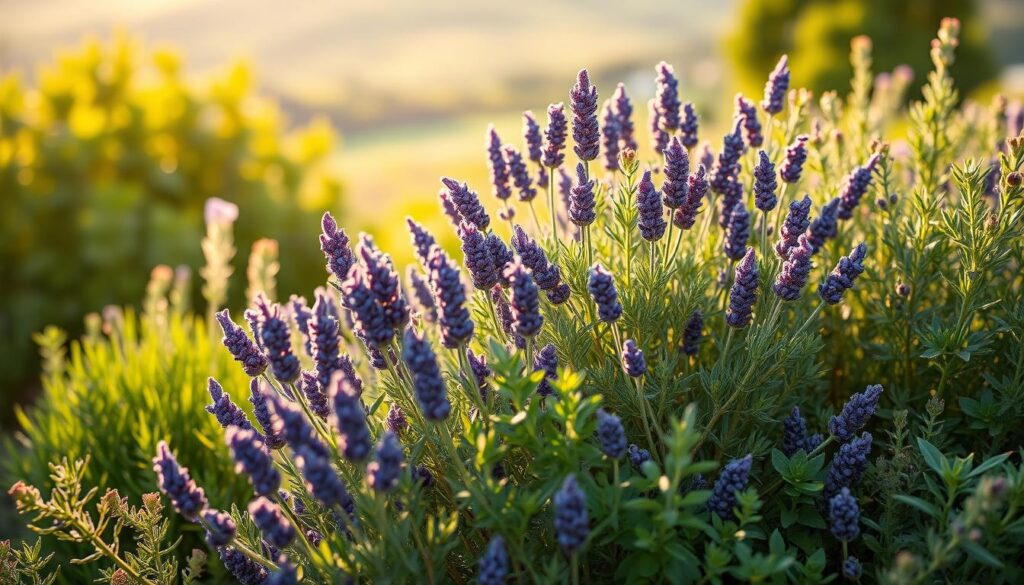
Pollinator-Friendly Plants for Lavender Gardens
Creating a beautiful lavender garden design goes beyond the allure of lavender alone. Attracting pollinators to lavender is crucial for a thriving ecosystem. Pollinators like bees and butterflies not only enhance the beauty of your garden but also improve the productivity of your plants through effective pollination. Incorporating the right plants can help you build a vibrant habitat that benefits both you and the local wildlife.
Why Pollinators Matter
Pollinators play a vital role in the lifecycle of many plants. Their presence leads to an increase in fruit and vegetable yields, making your gardening efforts more fruitful. By attracting pollinators to lavender, you ensure that your garden thrives and flourishes. Lavender serves as an excellent magnet for these insects, thanks to its fragrant flowers and long blooming season.
Choosing the Right Pollinator Plants
When selecting pollinator-friendly plants, look for companions that thrive in similar conditions as lavender. Echinacea and black-eyed Susan are perfect examples. Their overlapping blooming periods contribute to a continuous flow of nectar and pollen, encouraging bees and butterflies to linger in your garden. Incorporate these plants into your lavender garden design to create an inviting atmosphere for pollinators.
How to Attract Bees and Butterflies
To successfully attract bees and butterflies, maintain a diverse planting scheme. Utilize various pollinator-friendly plants that flower throughout the growing season. Avoid using pesticides, as they can deter these beneficial insects. Cultivating a welcoming environment that includes plants suited for attracting pollinators will keep your garden alive with activity.
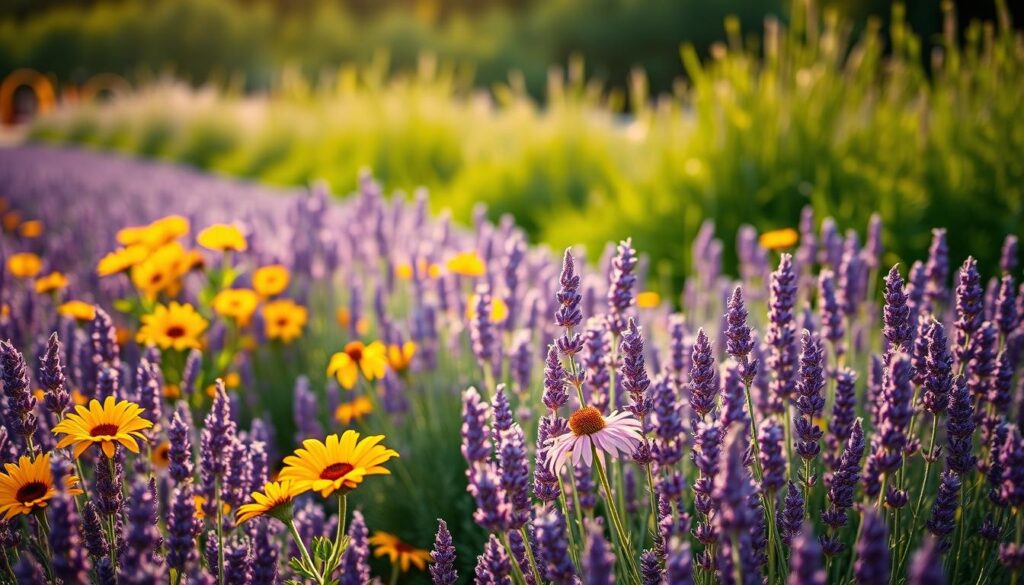
| Plant Type | Blooming Season | Attracts |
|---|---|---|
| Echinacea | Summer to Fall | Bees, Butterflies |
| Black-eyed Susan | Summer to Fall | Bees, Butterflies |
| Lavender | Summer | Bees, Butterflies |
| Salvia | Spring to Fall | Bees, Hummingbirds |
| Bee Balm | Summer | Bees, Butterflies |
Vegetables That Benefit from Lavender
When considering vegetables compatible with lavender, understanding their mutual benefits can enhance your garden. Companion planting with lavender not only makes your garden visually pleasing but also promotes healthier plant growth. Let’s explore some of the best plants to grow with lavender, focusing on tomatoes, peppers, and carrots.
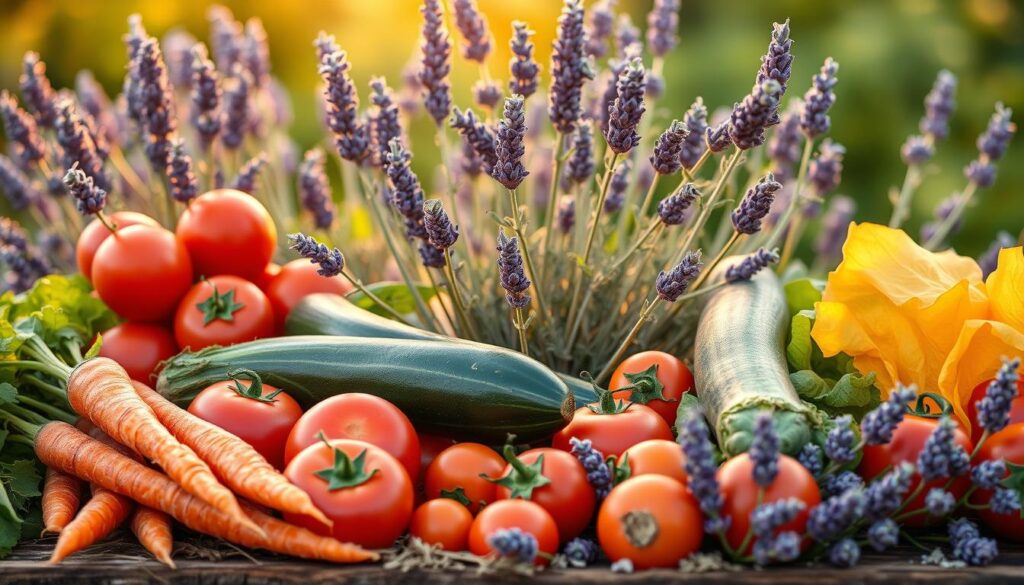
Tomato: A Symbiotic Relationship
Tomatoes thrive when planted near lavender due to lavender’s natural pest-repelling properties. This partnership aids in improved pollination rates while enhancing the aesthetic appeal of your lavender garden design. Consider their differing water needs to ensure that both plants flourish together.
Peppers: Growing Together for Success
Peppers and lavender share ideal growing conditions, thriving in full sun and well-drained soils. Planting peppers alongside lavender can help shield them from harmful pests like aphids, boosting their health. This combination shows how companion planting with lavender leads to a thriving garden ecosystem.
Carrots: Drawing Away Pests
Carrots can benefit greatly from a partnership with lavender. The lavender’s scent serves to deter pests that may plague carrots while attracting beneficial pollinators. Space your plants appropriately to allow each to meet its growth requirements and enjoy the benefits of this fantastic pairing.
Flowers That Enhance Lavender Gardens
Creating a vibrant lavender garden involves careful selection of complementary flowers. Flowers that enhance lavender gardens not only beautify the landscape but also promote biodiversity and attract pollinators. Choosing the right floral combinations can elevate your lavender garden design, ensuring a stunning visual display that thrives year-round.
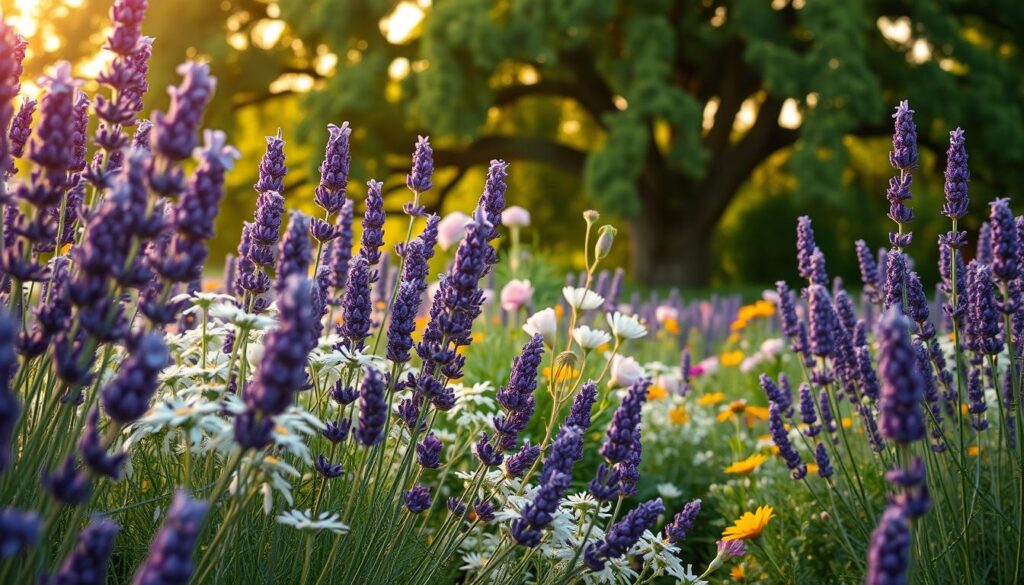
Salvia: A Colorful Companion
Salvia adds a burst of color to your garden, ranging from deep blues to bright reds. These flowers thrive in similar growing conditions as the lavender plant companions, requiring full sun and well-drained soil. Their elongated blooms not only create visual interest but also draw in bees, making them excellent pollinator-friendly plants. This pairing enhances both aesthetics and functionality in your lavender garden combinations.
Echinacea: Attracting More Wildlife
Echinacea, commonly known as coneflower, complements lavender’s beauty with its striking purple and pink blossoms. This flower is not just visually appealing; it serves as a magnet for various pollinators, including butterflies and bees. By combining Echinacea with lavender, you promote a vibrant ecosystem that supports wildlife while enhancing the overall garden design.
Coreopsis: Brightening Your Space
Coreopsis shines with its cheerful yellow and orange blooms, creating a lively contrast alongside lavender. Preferring the same sunny environments and lean soils, Coreopsis fits well into your lavender garden design. This synergy allows for a dynamic floral display that not only uplifts the landscape but also attracts essential pollinators, boosting the garden’s health and beauty.
Integrating these beautiful flowers into your lavender garden can significantly improve both its aesthetic appeal and ecological value. Consider mixing these flowers to create a vivid, lively atmosphere where your lavender thrives alongside its floral companions.
Boosting Pest Control with Companion Plants
In the quest for a lush and beautiful garden, integrating pest-repelling companion plants can make a significant difference. Utilizing natural pest barriers through companion planting with lavender provides effective strategies against unwanted insects. By thoughtfully selecting the right plants, you can enhance garden health and minimize the need for chemical treatments.
Natural Pest Deterrents
Plants such as marigolds and garlic serve as exceptional natural pest deterrents. Marigolds are known to repel nematodes and harmful insects, while garlic offers antifungal properties that protect nearby lavender plants. The combination of these pest-repelling companion plants creates a healthier environment for your lavender companion plants.
Best Plants for Repelling Pests
When considering which plants to pair with lavender, focus on the following:
- Marigolds: Effective against various insects.
- Garlic: Provides antifungal benefits.
- Thyme: Deters harmful pests while thriving alongside lavender.
- Chives: Repels aphids and adds flavor to your garden.
How Lavender Acts as a Pest Repellent
The fragrant aroma of lavender serves as a natural repellent for pests like ants, aphids, and whiteflies. Strategically placing lavender in your garden can effectively minimize pest populations, offering a proactive measure for lavender pest control tips. The synergy created through companion planting with lavender not only protects lavender but enhances the overall vitality of your garden.

Creating a Balanced Garden Ecosystem
Fostering biodiversity in gardens creates a vibrant and thriving environment. A diverse plant selection not only enhances the beauty of your space but also invites various pollinators and beneficial insects. By incorporating effective companion planting techniques, you can cultivate a rich ecosystem that supports robust growth and soil health.
The Importance of Biodiversity
A diverse range of plants contributes to healthy garden ecosystems. Biodiversity promotes resilience against pests and diseases, making your lavender garden thrive. Incorporating different species ensures that various pollinators visit your garden, boosting the productivity of your lavender plant companions.
Companion Planting Strategies
Utilizing companion planting techniques requires understanding plant relationships. Grouping herbs, vegetables, and flowers with similar sunlight and moisture needs can lead to thriving interactions. For example, planting lavender alongside rosemary not only enhances flavors but also optimizes space and encourages growth.
Seasonal Considerations in Planting
Being mindful of your planting season tips can make a significant difference. Timing is critical when growing lavender in different seasons; proper planning ensures that blooming periods align. Planting at the right time helps prevent overcrowding and minimizes competition for resources among plants.
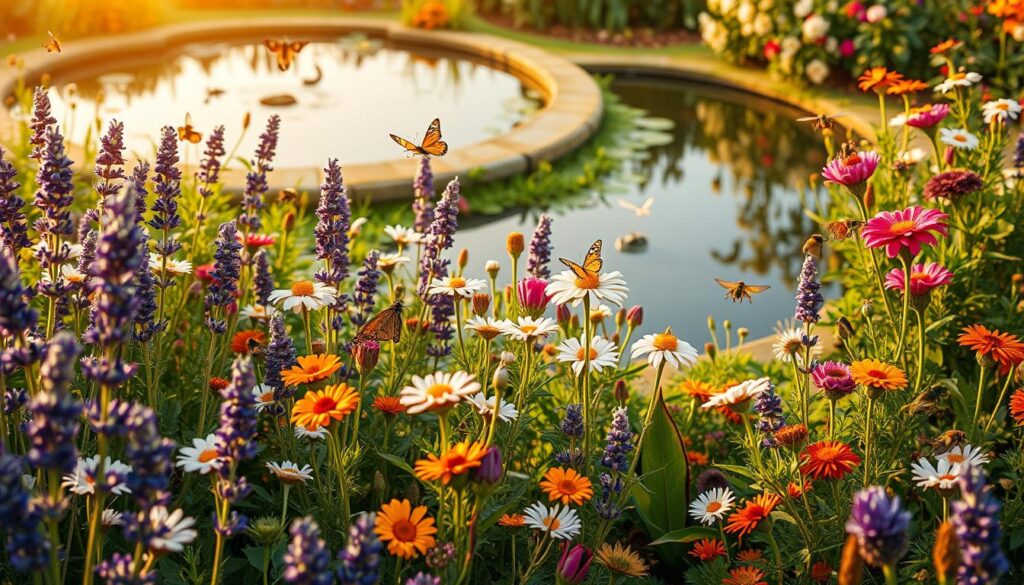
Environmental Benefits of Lavender Companion Planting
Incorporating companion plants for lavender can significantly enhance your garden’s overall health and sustainability. By understanding how these plants interact, you can enjoy numerous gardening benefits, including improved soil vitality, water conservation, and space efficiency.
Improving Soil Health
Soil health improvement with lavender occurs as various plants decompose in harmony, adding organic matter to the soil. The diverse root structures of lavender and its companions promote better aeration and moisture retention. This natural synergy ensures nutrient cycling, creating a thriving ecosystem beneath the surface.
Water Conservation Techniques
Implementing water-saving gardening practices becomes easier when you choose drought-tolerant companion plants for lavender. These hardy plants work together to reduce overall water usage while keeping the soil moist. This partnership not only conserves water but also cultivates a resilient, sustainable garden environment.
Maximizing Space in Your Garden
Space conservation in gardening is achievable with thoughtful planting strategies. Growing lavender in tight spaces allows you to utilize vertical gardening methods and interplanting techniques. This smart arrangement maximizes your garden area, ensuring that every inch is filled with vibrant blooms and healthy growth.
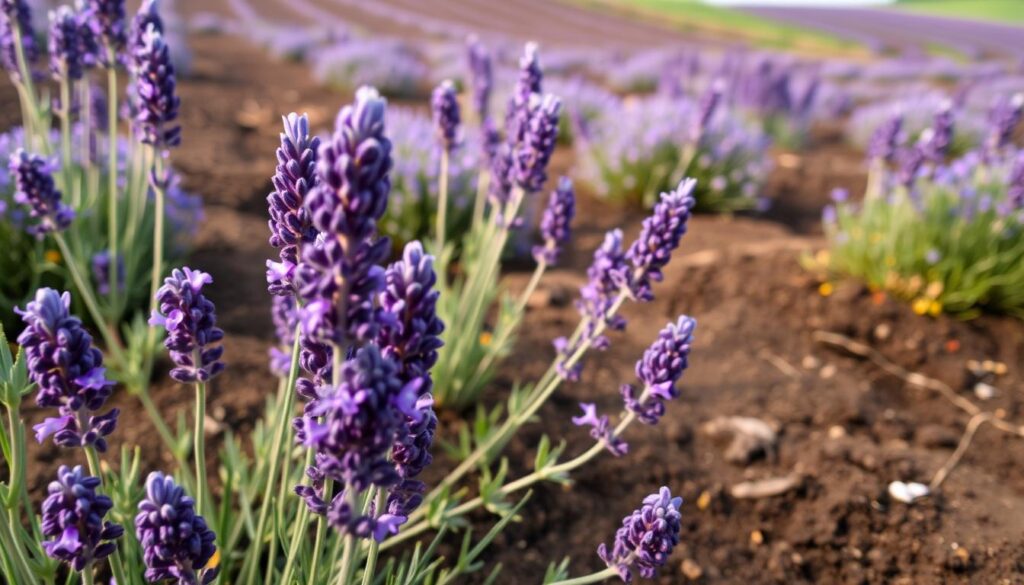
Growing Lavender in Pots with Companions
Container gardening with lavender allows you to enjoy the beauty and fragrance of this beloved plant even in limited spaces. When growing lavender in pots, selecting the right companions enhances both aesthetics and growth conditions. Here are some key tips to help you create a thriving potted garden.
Container Gardening Tips
To ensure your lavender thrives while growing companion plants, opt for well-draining containers. These will prevent moisture buildup and reduce the risk of root rot. It is beneficial to mix drought-tolerant herbs and small flowering plants with lavender to simplify care while enhancing visual appeal.
Choosing the Right Potting Mix
For successful container gardening with lavender, select a potting soil for lavender that supports proper drainage. A mix containing sand and perlite will promote aeration, crucial for lavender’s growth. Combining it with other companions that share similar water needs can create an efficient watering system within the pot.
Recommended Sizes for Companion Plants
When managing gardening space, consider container sizes for lavender companions carefully. Using pots large enough will allow each plant enough room to flourish without overcrowding. Maintaining adequate spacing among companions promotes healthy growth and minimizes competition for nutrients.
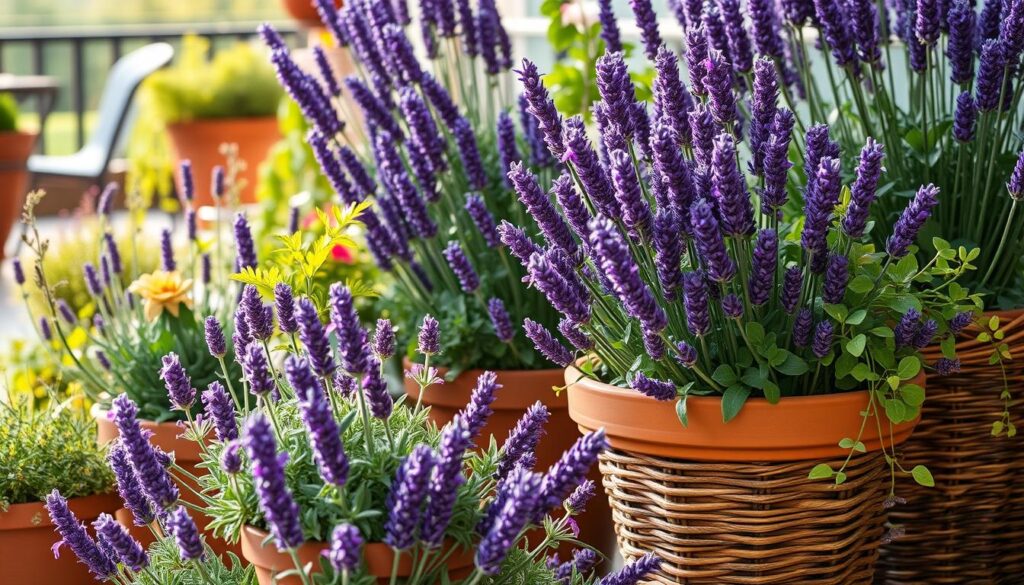
| Container Size | Recommended Companion Plants | Growth Type |
|---|---|---|
| 8-10 inches | Thyme, Oregano | Small Herbs |
| 12-14 inches | Sage, Marigolds | Medium Herbs & Flowers |
| 16 inches and above | Rosemary, Echinacea | Larger Herbs & Flowers |
Seasonality and Companion Planting
Effective gardening throughout the year requires strategic planning. Implementing year-round gardening tips enhances the visual appeal of your space while ensuring consistent productivity. By integrating succession planting with lavender, you can enjoy blooms and harvests at different times of the year. Establishing a well-structured planting schedule for lavender and its companions can lead to a thriving garden.
Planning for Year-Round Blooms
Selecting plants that bloom at various times ensures vibrant colors across seasons. This not only creates a delightful landscape but also supports pollinator activity. Consider using seasonal gardening techniques to understand when to plant each companion plant, allowing for a continuous show of flowers and foliage.
Seasonal Planting Schedule
A well-defined seasonal planting schedule is crucial for maximizing garden potential. By grouping plants based on their flowering times, you can determine when to sow seeds or transplant seedlings. For instance, early spring may be ideal for sowing varieties that pair well with lavender, while other companions might flourish in summer. Tracking these timelines can significantly enhance your garden’s performance.
Benefits of Succession Planting
The benefits of succession planting extend beyond aesthetics. This technique allows for multiple harvests from the same space throughout the growing season. By cyclically planting compatible crops, including lavender, you optimize your garden’s output and maintain fresh produce. You can enjoy fragrant blossoms in spring, followed by delicious herbs or vegetables later in the season.
| Season | Companion Plants | Blooming Period |
|---|---|---|
| Spring | Pansies, Snapdragons | March to May |
| Summer | Salvia, Echinacea | June to August |
| Fall | Asters, Mums | September to November |
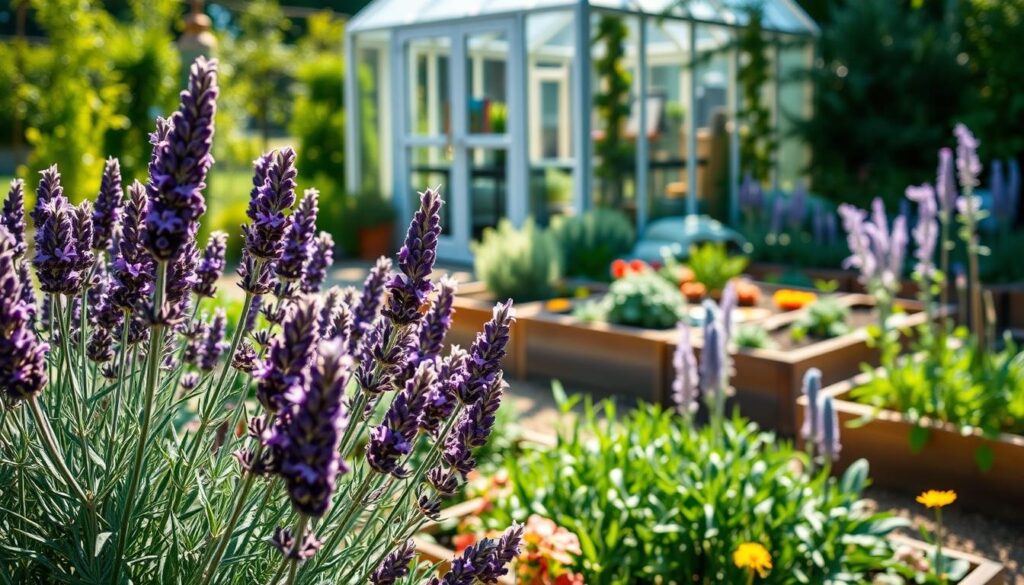
Common Mistakes to Avoid
Creating a thriving lavender garden involves understanding and steering clear of common gardening mistakes to avoid. When planning your lavender plant spacing, consider how each companion plant interacts with lavender and adheres to its care requirements. Neglecting these aspects can lead to poor growth, pest issues, and an unbalanced garden ecosystem.
Overcrowding Plants
One of the major challenges in gardening is overcrowding. When planting lavender and its companions too close together, competition for nutrients and water arises. This can hinder the growth of all plants involved. Maintaining proper lavender plant spacing allows for air circulation, reduces the risk of diseases, and supports healthier plants.
Choosing Incompatible Species
It is crucial to avoid pairing lavender with incompatible companion plants. Selecting plants that require different moisture, sunlight, and soil pH levels can lead to stunted growth and unproductive plantings. Researching plants to avoid with lavender ensures a more harmonious and vibrant garden.
Ignoring Care Requirements
Every plant species has unique care requirements that need to be respected for optimum health. Ignoring lavender plant care tips can lead to reduced growth and vitality in your garden. Familiarize yourself with the specific needs of lavender and its companions to effectively manage and cultivate your plants for the best results.
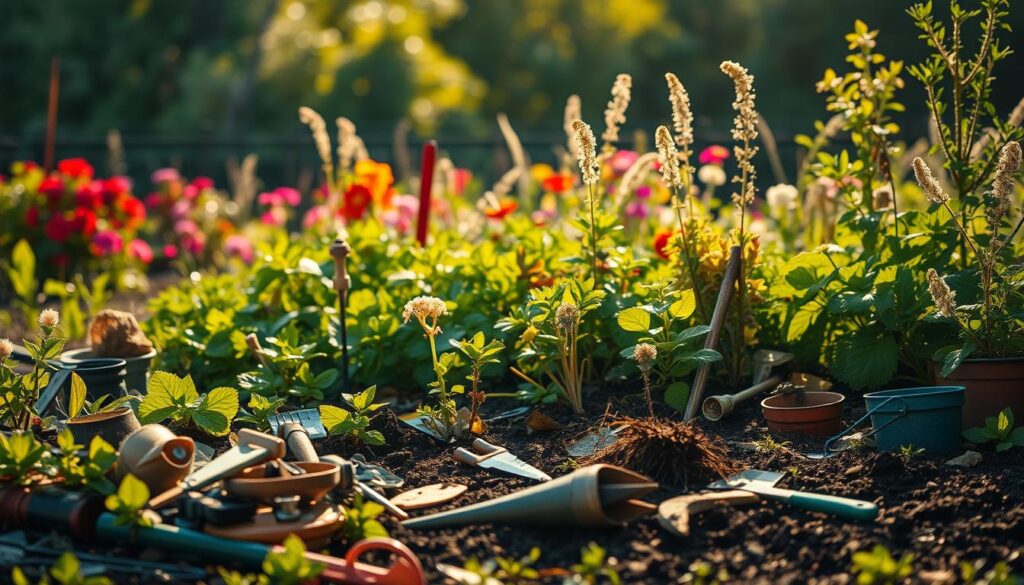
| Mistakes to Avoid | Consequences | Solutions |
|---|---|---|
| Overcrowding Plants | Competition for nutrients and water | Maintain appropriate lavender plant spacing |
| Choosing Incompatible Species | Stunted growth and failure in productivity | Research plants to avoid with lavender |
| Ignoring Care Requirements | Reduced plant health and yield | Follow lavender plant care tips for both lavender and companions |
Resources for Further Learning
Expanding your gardening knowledge can lead to a more successful lavender garden. Several excellent resources are available to help you navigate the world of companion planting. By exploring these various avenues, you can connect with like-minded individuals and deepen your understanding of the intricacies in your garden. Here are some valuable gardening resources along with engaging communities and educational opportunities.
Recommended Books on Companion Planting
Many informative books on companion planting illustrate the relationships between different plants. Notable titles such as “Carrots Love Tomatoes” by Louise Riotte and “The Garden Primer” by Barbara Damrosch offer in-depth insights for gardeners at any level. These resources can serve as great guides in optimizing your combinations for the best results.
Online Communities and Forums
Engaging with online gardening communities provides a platform for sharing experiences and obtaining helpful insights. Websites such as GardenWeb and Reddit’s gardening forums are fantastic places to ask questions and exchange tips related to companion planting. Various members often share their successes and challenges, creating a rich learning atmosphere.
Gardening Workshops and Classes
Participating in local gardening workshops offers hands-on learning opportunities in gardening techniques. Community centers and botanical gardens frequently organize classes that help enhance your skills. Connecting with fellow enthusiasts during these sessions not only enriches your knowledge but can spark friendships that grow beyond the garden.
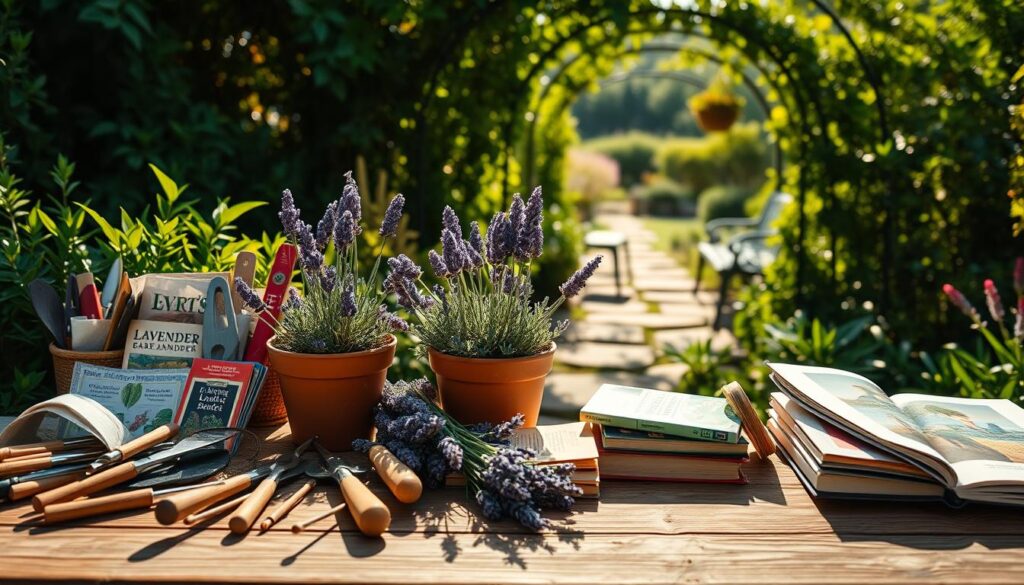
Frequently Asked Questions
As you explore the world of lavender, several questions may arise regarding its cultivation and care. Understanding the nuances of growing plants with lavender can enhance your gardening experience. Below are answers to some frequently asked questions.
Can I grow other plants with lavender?
Yes, you can successfully grow various plants alongside lavender. When selecting companions for your lavender companion gardens, ensure that they share similar sunlight and water needs. Plants that require full sun and well-draining soil will complement lavender’s growth.
What are the best conditions for lavender growth?
To achieve the best conditions for growing lavender, provide full sun exposure for at least 6-8 hours daily. Lavender thrives in well-draining soil, slightly alkaline in nature. Regular attention to soil quality and sunlight will help promote healthy growth.
How often should I water lavender and its companions?
A clear watering schedule for lavender involves deep watering during its establishment phase, typically in the first few weeks. Established lavender plants have lower watering requirements, which suits many companion plants with similar needs. Tailor your watering routine based on the specific requirements of each plant species.
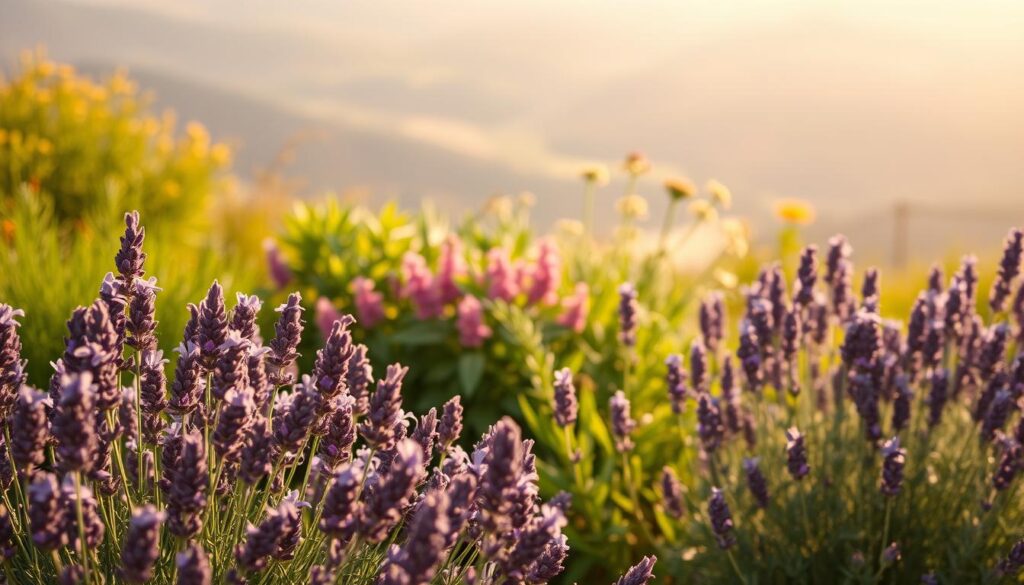
Utilizing these lavender care tips will allow you to create a thriving environment for both lavender and its companions in your garden.
Final Thoughts on Lavender Companion Plants
As you reflect on the benefits of lavender companion planting, it’s clear that pairing lavender with appropriate garden companions can enhance both aesthetics and ecosystem health. Optimal companions not only elevate the beauty of your garden but also promote healthier growth and effective pest management, ultimately leading to a more vibrant outdoor space. Embracing these relationships allows you to cultivate a sustainable and thriving garden environment.
When starting your lavender garden, begin by assessing your garden’s light and soil conditions. Choose species that will work harmoniously together, focusing on perfect lavender combinations for your specific environment. Starting small with groups of plants will let you monitor their growth and ensure successful pairings. You’ll quickly learn which combinations thrive best in your unique space.
Designing a lavender garden can be a fun and rewarding experience. Consider the layout carefully, including sunlight, space, and the specific needs of your garden companions. By implementing seasonal variety and selecting species that flourish together, you can create a stunning, functional, and fragrant oasis that will delight the senses throughout the year. With thoughtful planning, every step in planting lavender companions will pave the way for your dream garden.
